
Walter Hammond Righter (1905 - 1982)An Illustrated Biography by his daughter, Frances Jean Righter Tucker © 2005
Chapter 1. Home Home on the Ranch : Part 1Last Updated : July 4, 2005
Some of his achievements others took credit for, which Dad didn't much worry about. He just loved working on his current project. Since I have his files, I thought I would set some of the record straight, if not for others to read, at least for our three children and seven grands. He had accomplished so much that it could take years to finish. When I was thinking about his personality and character, his wit and where his genius came from, I started checking his background and VOILA there it was! Then I got side tracked on his genealogy-boy, did I!
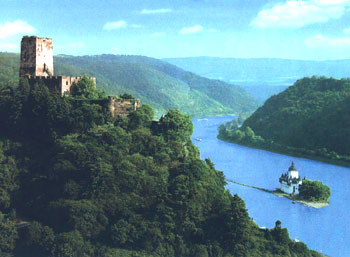 The famous Rhine River in Germany Photo: Righter Family Archives - Click Image to Enlarge
Their grandson, Wilhelmus Richter, born in 1748, was the first to move to Pine Plains, New York and was the first owner of the Righter homestead. He "Americanized" his name to Righter and was known as William Righter Esquire. He served as Justice of the Peace, settled estates for people and pleaded cases before the Justice Court. The name Richter/Righter means judge/magistrate. And that, as well as farming, is what they were and did for several generations.
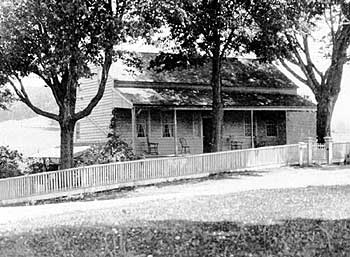 The Old Farm House, (built in 1787), Pine Plains, NY., c.1860 The Righter generations lived in it for 159 years Photo: Righter Family Archives - Click Image to Enlarge View a panoramic photo
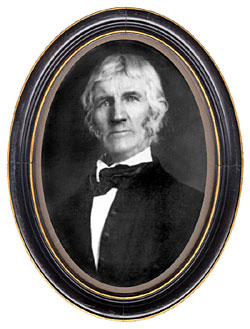 John Walter Righter (1779-1862) Father of John Righter, great grandfather of Ruth V. Righter and Walter H. Righter and great, great, grandfather of Frances J. Righter and Catherine L. Righter Photo: Righter Family Archives : Click Image to Enlarge
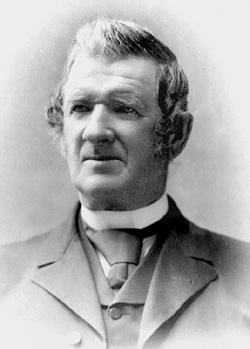 John Righter (1820-1918) Son of John Walter Righter, father of William Jay "Will" Righter and grand father of Walter H. Righter and Ruth V. Righter Photo: Righter Family Archives : Click Image to Enlarge
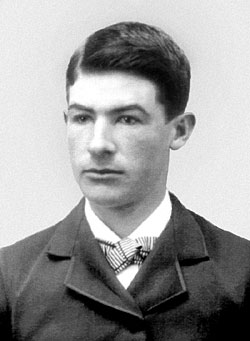 William Jay "Will" Righter (1858-1956), c.1878 Son of John Righter, father of Ruth V. Righter and Walter H. Righter and grandfather of Frances J. Righter and Catherine L. Righter Picture made from a tintype the size of a postage stamp. Photo: Righter Family Archives - Click Image to Enlarge
I don't know how far back the humor goes, but I do know that my Grandfather, William Jay Righter, "Will", had a great sense of humor that has emerged somewhere in each descending generation. It warms my heart to see these ancestral traits trickle on down through the family.
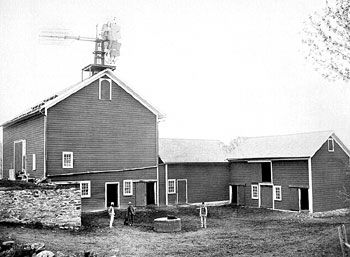 The Old Barn, Pine Plains, NY, (date tba) Photo: Righter Family Archives - Click Image to Enlarge View a 1500pixel image
Grandpa was born May 2, 1858 in Pine Plains, New York on a farm that had seen four generations grow up in the same old house. This was a time when they had spinning wheels and made their own cloth, there was no running water or electricity and they had to feed their transportation oats or they might have a very long barefoot walk to school. Pine Plains was formed in 1823 supposedly deriving its name from early deeds, which included descriptions of 'the pine plainsGradually, during his lifetime, he saw the first electric lights, phonographs, (victrolas), and telephones arrive upon the scene and the horse and plow replaced by a noisy chugging tractor. He watched the first trains heading west and wished he were on board. Wars had been fought, won and lost-the Civil War, World War I, and WWII with the big depression in between. He had worked his way to the wild-wild West, even dodging hostile Indians along the way.
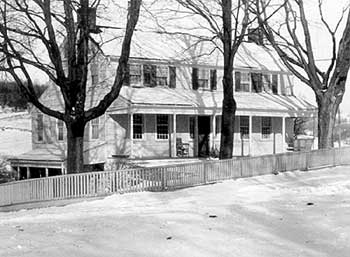 The Old Farm House (remodelled), Pine Plains, NY, c.1920 Photo: Righter Family Archives - Click Image to Enlarge
They had him hauling out ore with a train of dump cars and a horse. The mine opening was at the bottom of a canyon and went into an almost vertical rock face. The mineshaft gently sloped upward from the entrance. The procedure was to haul the ore cars into the mine with the horse where the miners filled the eight or ten cars with ore. Then he and the horse got onto the last car (a low flat car) and coasted outside to the ore dump. He controlled the speed with a heavy stick, which he pried against a car wheel as a brake.
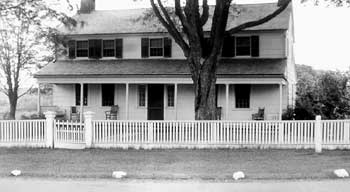 The Old Farm House, Pine Plains, NY, 1938 Photo: Righter Family Archives - Click Image to Enlarge
The mine produced both gold and silver that was refined at the mine site. Bullion was transported on horseback to Hermosillo in saddlebags. Grandfather's job, together with four other men, was to ride back and forth between the mine and Hermosillo. They were the ones who carried silver dollars into the mine to pay the miner's for their work and took the gold and silver bouillon back in the other direction. One of the five men who transported ore was well armed for the Yaquis Indians who were often "on the war path". One time they were forewarned of a band of Yaquis roaming in their area looking for trouble. So they took a wide circuitous route to avoid a fight and kept a man on sentry duty when they camped at night. One morning, shortly after sunrise, while they were eating breakfast a deer wandered up to with in a hundred feet of them. All sat quietly, hardly breathing while their reputedly crack-shot guard tried to take aim and fire. However, he was shaking so badly from "buck fever" that he missed the deer entirely and shot himself in the foot. Before anyone could reload the deer had vanished. They managed to get back to Hermosillo without any major problems, but Grandpa quit the job on the spot. He said, "If the best shot we had gets buck fever with a deer looking at him, I would hate to think what he would do with a band of Yaquis shooting arrows at him." It was a very dangerous job, and we are very glad he quit!
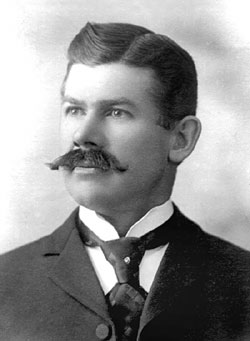 William Jay "Will" Righter, 1899 Photo: Righter Family Archives - Click Image to Enlarge View another photo from the same sitting
In the beginning, each day he had to walk with a large five gallon bucket in each hand a quarter of a mile to a neighbouring ranch where there was a windmill and a well where he could draw water for cooking, washing, and drinking for them, a cow and the horses. Don Gaspár de Portolá, a Spanish expedition party leader, discovered a picturesque valley and river in Southern California which he christened Santa Ana, in honor of Saint Anne, on July 26, 1769. José Antonio Yorba, a youthful expedition soldier, and his nephew Juan Peralta, were given a Spanish land grant for the area. They developed the Rancho Santiago de Santa Ana for cattle grazing and productive farmland. 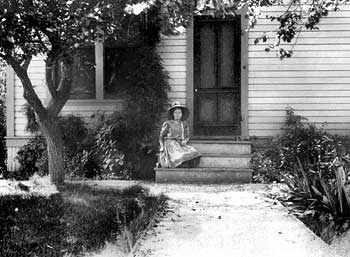 Ruth Virginia Righter at the ranch house, Santa Ana, CA, c.1915-20 Photo: Righter Family Archives - Click Image to Enlarge
Their two barns came down and a double garage went up. A long workbench was added along one wall and a large storage loft built up stairs.
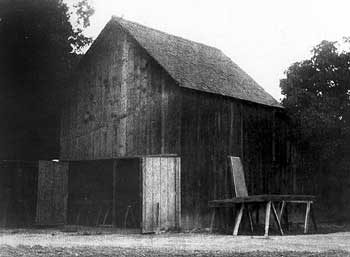 The old livestock stable Photo: Righter Family Archives - Click Image to Enlarge
Grandpa had proudly watched his daughter and son graduate from college and saw the results of their careers. Before he died, January 17, 1956, he had two grand daughters who adored him, one great grand daughter and a television set. Now he could watch his grand daughter, Catherine, Monday through Friday on television.
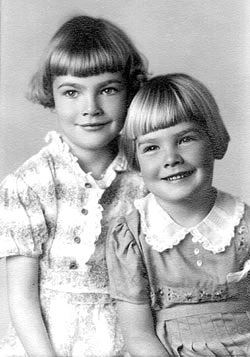 Grandaughters, Fran 7 1/2 and Cathie 5, 2048 Watson St. Glendale, CA. 1937 Photo: Righter Family Archives - Click Image to Enlarge
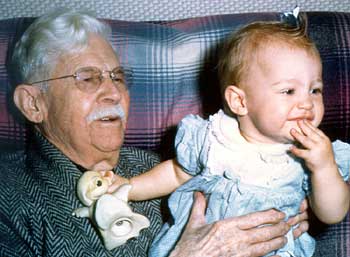 W.J. "Will" Righter and his great grand daughter Candace, Dec., 1953 Photo: Righter Family Archives - Click Image to Enlarge
Ancestors from London, England and Holland and related to William Penn
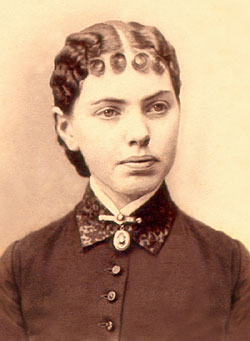 Ruth Emma Hammond Righter, c.1880 Photo: Righter Family Archives - Click Image to Enlarge
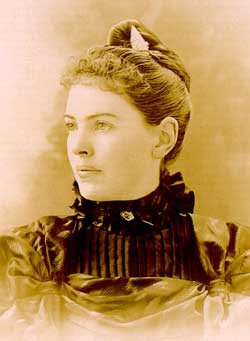 Ruth Emma Hammond Righter, March 1899 Photo: Righter Family Archives - Click Image to Enlarge
FASHIONABLE MODISTE Respectfully solicits a share of your patronage Orders taken for the JENNESS-MILLER UNDERWEAR 512 Main St., Santa Ana, California
There was a maintenance man whose job it was to keep the machines in running condition. But it often took more than an hour or two waiting for him to get there and get the job done. Some times there were several broken down at the same time. Since they were all on piecework and paid by the piece, lost time made a big difference in their pay. The girls would wait impatiently to have their machine fixed. Emma wouldn't wait. When her machine was down, being a natural mechanic, she fixed and adjusted it herself. The other girls noticed that her machine generally ran better than any of the others and they begged her to fix theirs. They made a deal to trade machines. The girl would sew Emma's garments while she waited for Emma to repair her machine. That way Emma's production was kept up at the same time she was doing the repairs. Emma enjoyed doing this repair work for two reasons - she dearly loved interesting mechanical problems, and it was also a change and a rest from pumping the heavy machine all day. There was a time when she had her own shop. Out front there was a sign:
DRESS MAKING TAYLOR SYSTEM
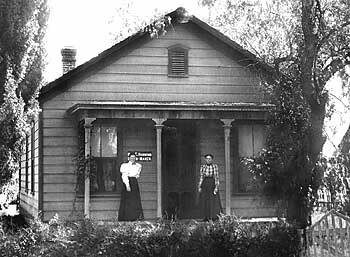 R. E. HAMMOND, DRESS MAKER, c1890 110 Church St., Santa Ana, CA Fran Righter Tucker notes : "Emma is wearing a "Leg 'O Mutton" blouse so I know the date would be around 1890 before she was married. I do not know who her helper is."
Photo: Righter Family Archives - Click Image to Enlarge
View the original panoramic image
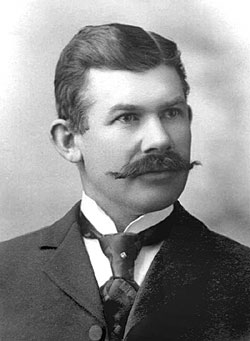 William Jay "Will" Righter in his wedding suit, 1899 Photo: Righter Family Archives - Click Image to Enlarge View another photo from the same sitting
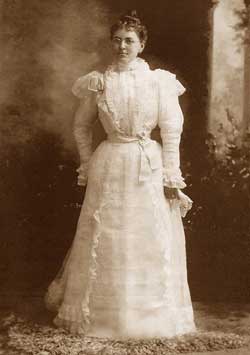 Ruth Emma Hammond, (1864-1932), Wedding Day, March 7, 1899 Photo: Righter Family Archives - Click Image to Enlarge View another photo from the same sitting
She was thrilled to be able to hold her first grandchild in March 1932. She died five months after I was born, at age sixty-eight. Grandpa out lived her by 30 years.
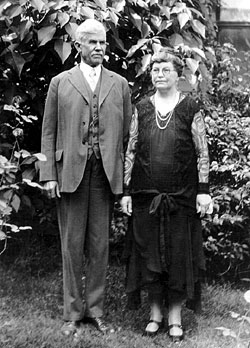 William Jay Righter & Ruth Emma Hammond / Righter c.1928 Photo: Righter Family Archives - Click Image to Enlarge
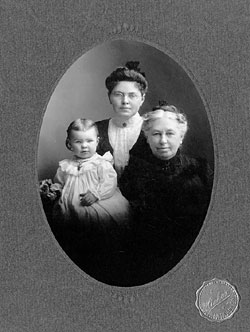 Ruth Virginia Righter one-year-old c.1902 L-R : Ruth, her mother Ruth Emma Hammond, and her mother Mary Jane Corbin/Hammond Photo: Righter Family Archives - Click Image to Enlarge
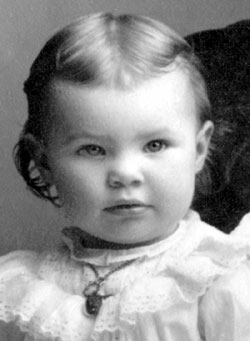 Ruth Virginia Righter one-year-old c.1902, (detail) Photo: Righter Family Archives - Click Image to Enlarge
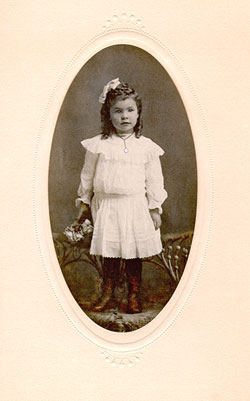 Ruth Virginia Righter five-years-old c.1904 Photo: Righter Family Archives - Click Image to Enlarge
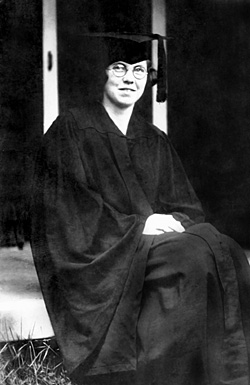 Ruth V. Righter's College Graduation Photo: Righter Family Archives - Click Image to Enlarge
Top | Walter Righter Home | Reginald Denny - Walter Righter Home |
© Copyright 1999-2005 CTIE - All Rights Reserved - Caution |